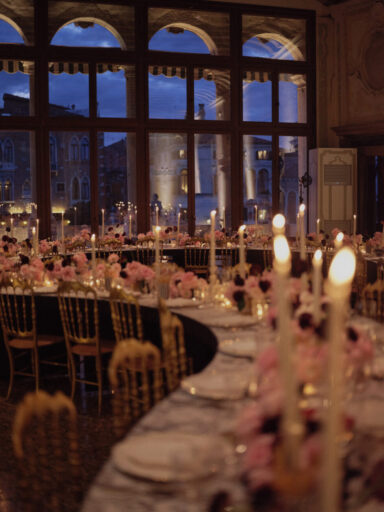Trompe l’oeil (French for ‘deceive the eye’) is an art technique that uses realistic imagery to create the optical illusion that the depicted objects exist in three dimensions. Jeremy Scott may not be the first designer to employ the trompe l’oeil technique to render three-dimensional clothes flat but might be the first designer to extend the metaphor and add the white folding tabs. We don’t know if they’ll make it all the way to the selling floor, but Moschino fans are so determined to get what they want, it wouldn’t surprise if they did. The spring-summer 2017 collection is a sequence of flat paper doll clothes, and absolutely everything is trompe-l’oeil, from fishnet tights with hot pants (they are leggings) to small wrap dresses with polka dots, passing trough chains, zippers and hats and reaching coats and evening suits decorated by enormous (and fake) bows and ruffles, from which emerge legs and arms ‘in position’. Playing the game, maybe repetitive in the long run, however, is fun and effective: the irony on fashion vacuity is obvious, though perhaps unintended, and the choice of Scott to leave the evening dresses white on the back only reinforces the idea that what matters, too often, it’s just what you see. The suggestion, as Scott said, comes from the cult novel, and then movie, Valley of the Dolls, centred about the rise and fall of three hopeful girls and their abuse of drugs (pills are the “dolls” of the title). And that’s where Scott had the right idea, by undoubling the significance of the term: to the dolls-pills, transformed in print, applications, bottle-bags and even umbrellas, he devotes a capsule collection for a ‘buy now’ sale, while on the paper dolls he focuses the spring-summer 2017 fashion show.
Valley of the Dolls is a novel by American writer Jacqueline Susann, published in 1966. An overnight success when it was first published, became the bestselling work of fiction of 1966, making it one of the bestselling books of all time, and in 1967 a drama film of the same name. The “dolls” within the title is an euphemism for pills (“dolls” was a slang term for downers, originally short for dolophine, which quickly came to refer to any barbiturates such as pentobarbital, used as sleep aids). The term represents the women’s reliance on stimulants, depressants, and sleeping pills, and how substance abuse is reminiscent of children clinging to toy dolls for comfort. The film has gained a cult following in subsequent years. It was re-released in 1969 following the murder of Sharon Tate, who was starring in the movie, and again proved commercially viable. Valley of the Dolls was included as one of the choices in the 1978 book The Fifty Worst Films of all Time. Co-star Barbara Parkins, attending a July 1997 screening of the film at the Castro Theatre in San Francisco, told the sold-out crowd, “I know why you like it… because it’s so bad!”. The movie was remade in 1981 for television as Jacqueline Susann’s Valley of the Dolls. As the first roman à clef by a female author to achieve an enormous level of sales in America (more than 30 million copies), it led the way for other authors such as Jackie Collins to depict the private lives of the real-life rich and famous under a veneer of fiction. The 1997 reissue by Grove Press calls the book “The All-Time Pop-Culture Classic” on its back cover.
Domenico Gnoli, Girocollo 15 1/2, 1966








